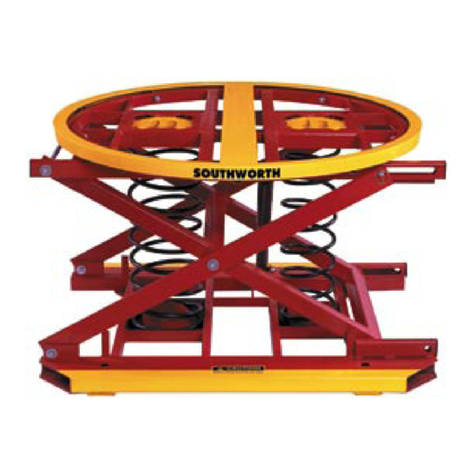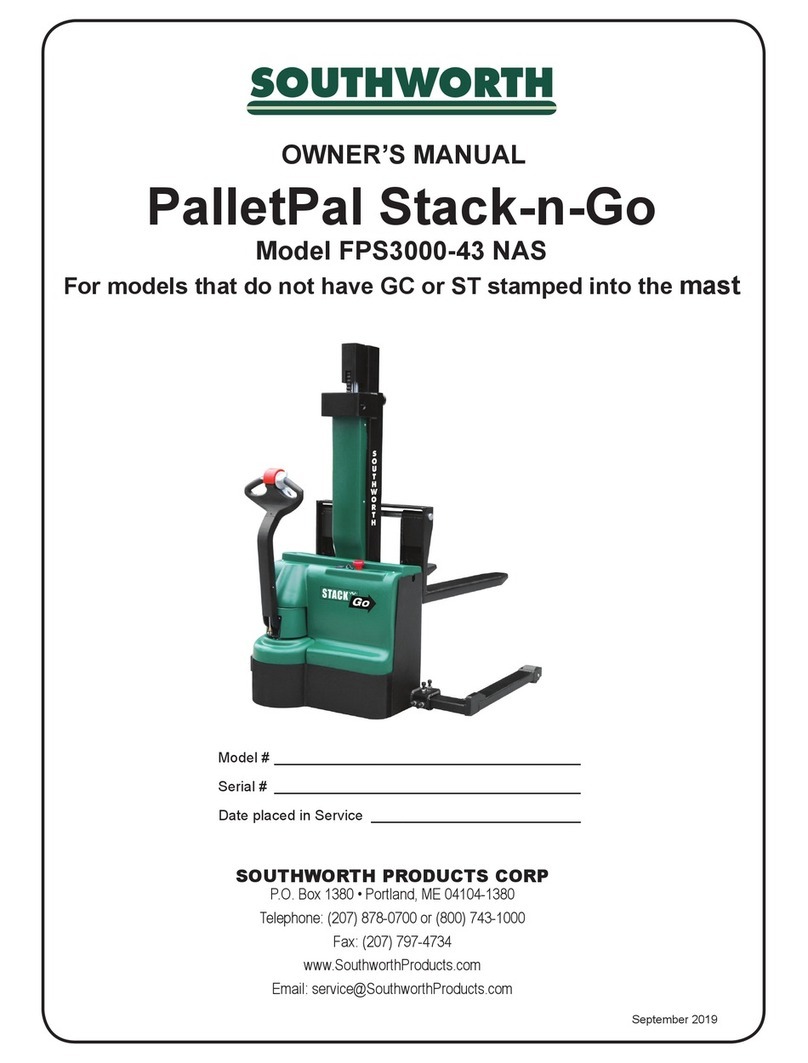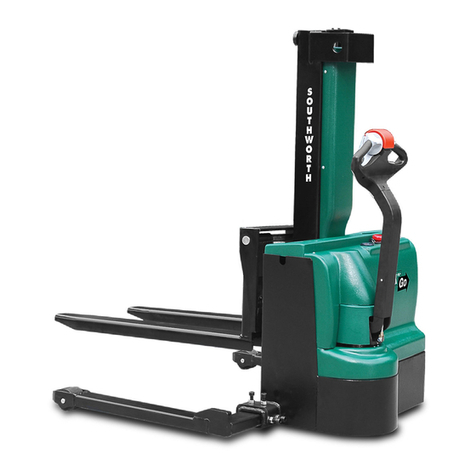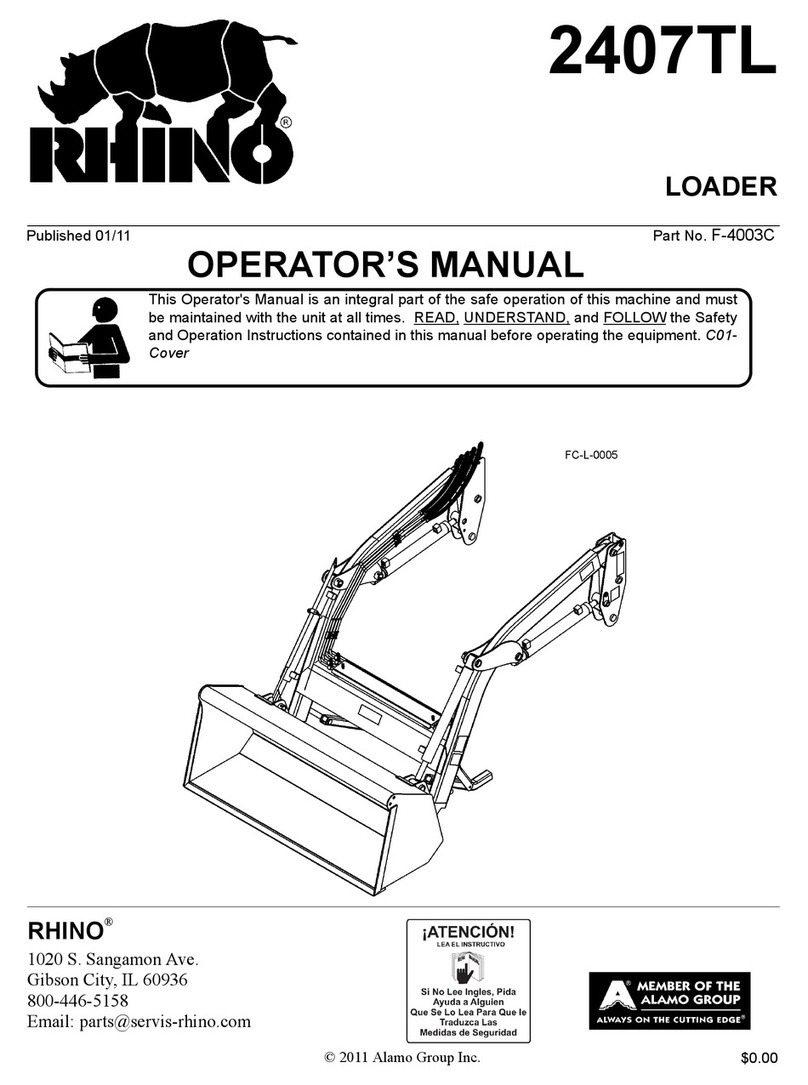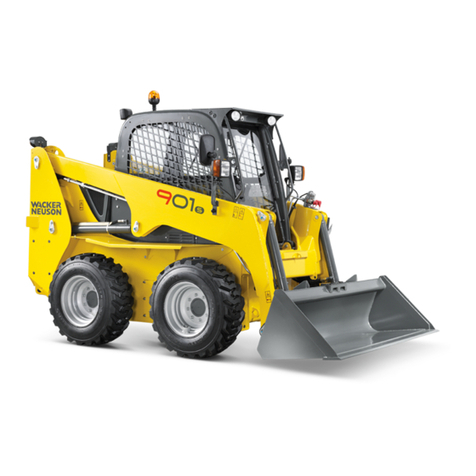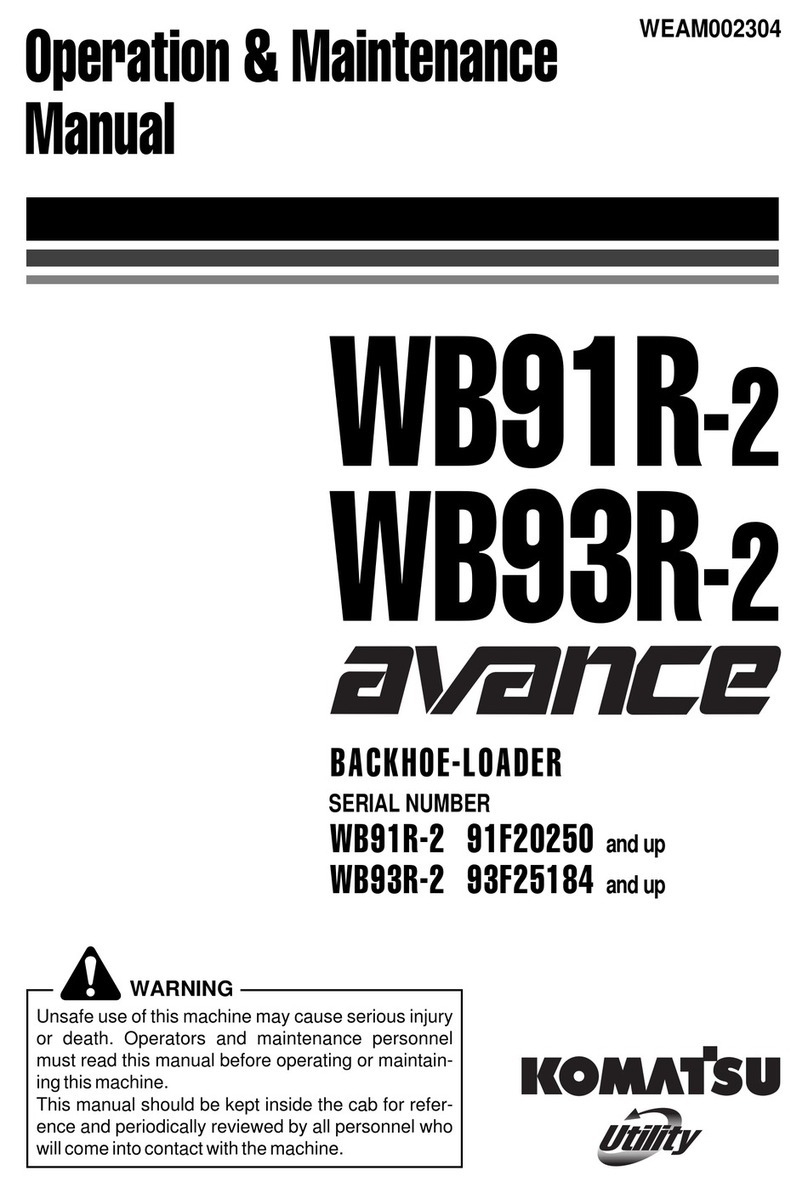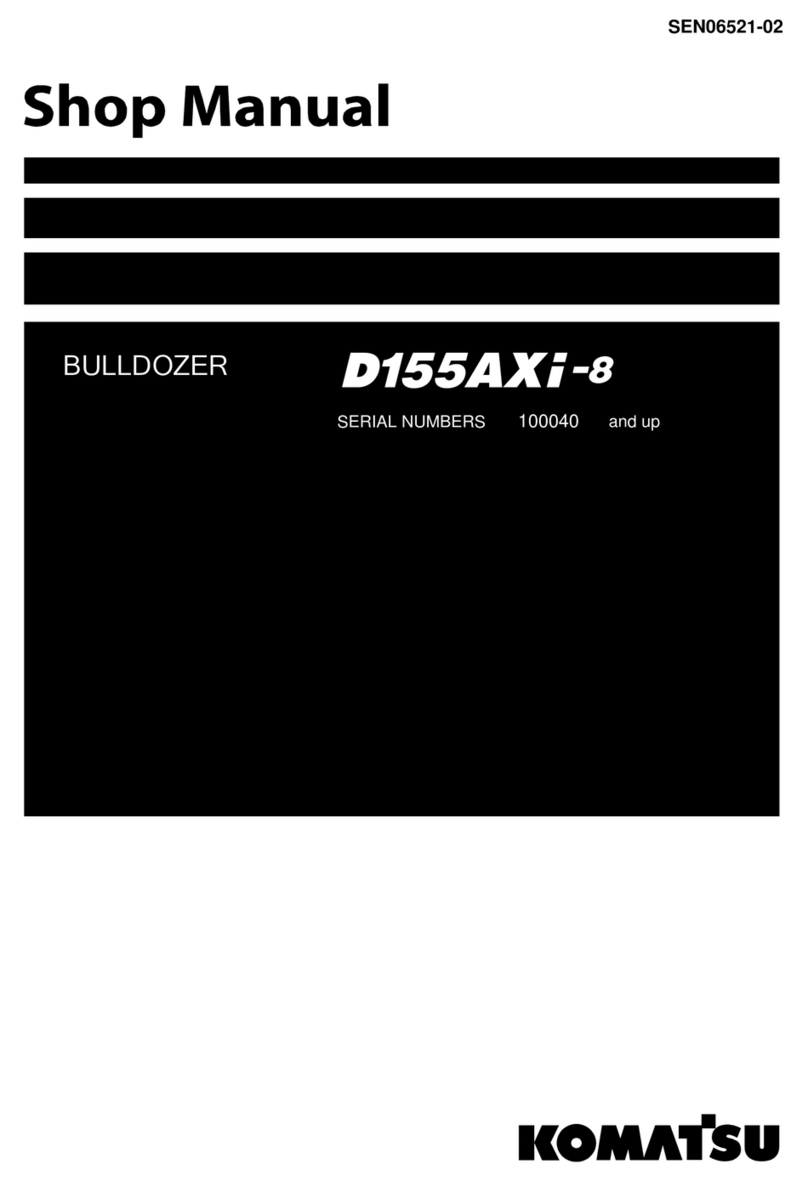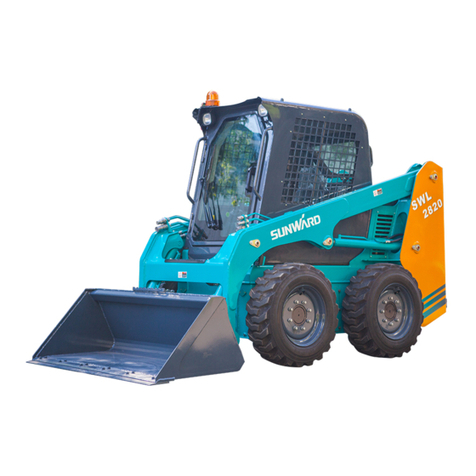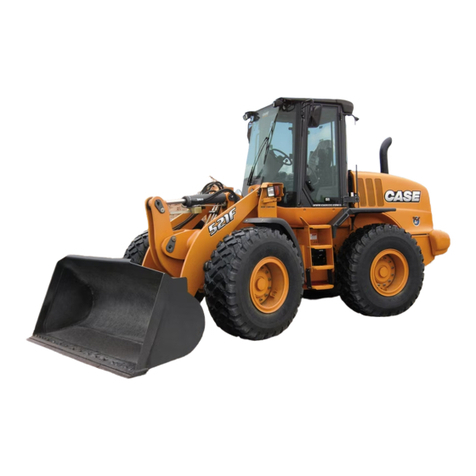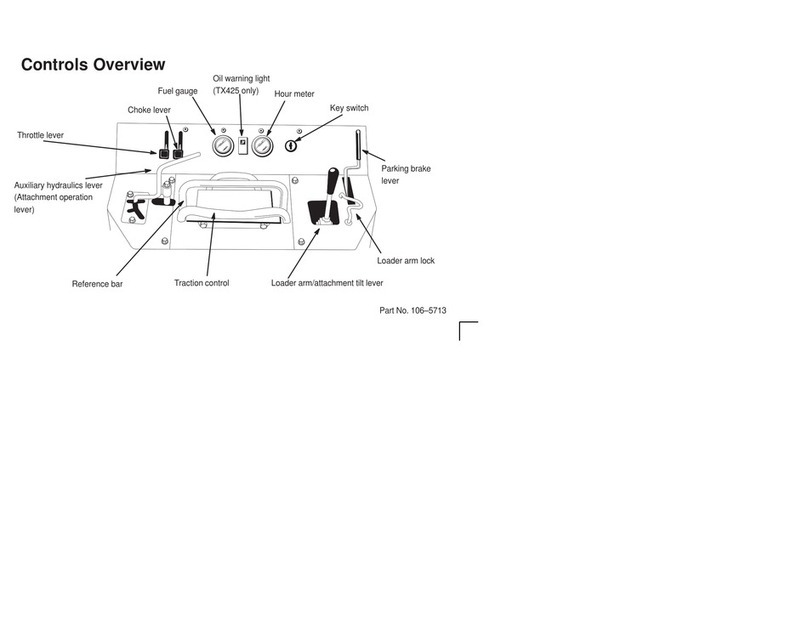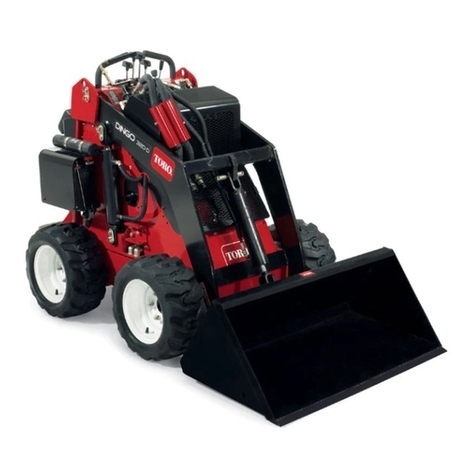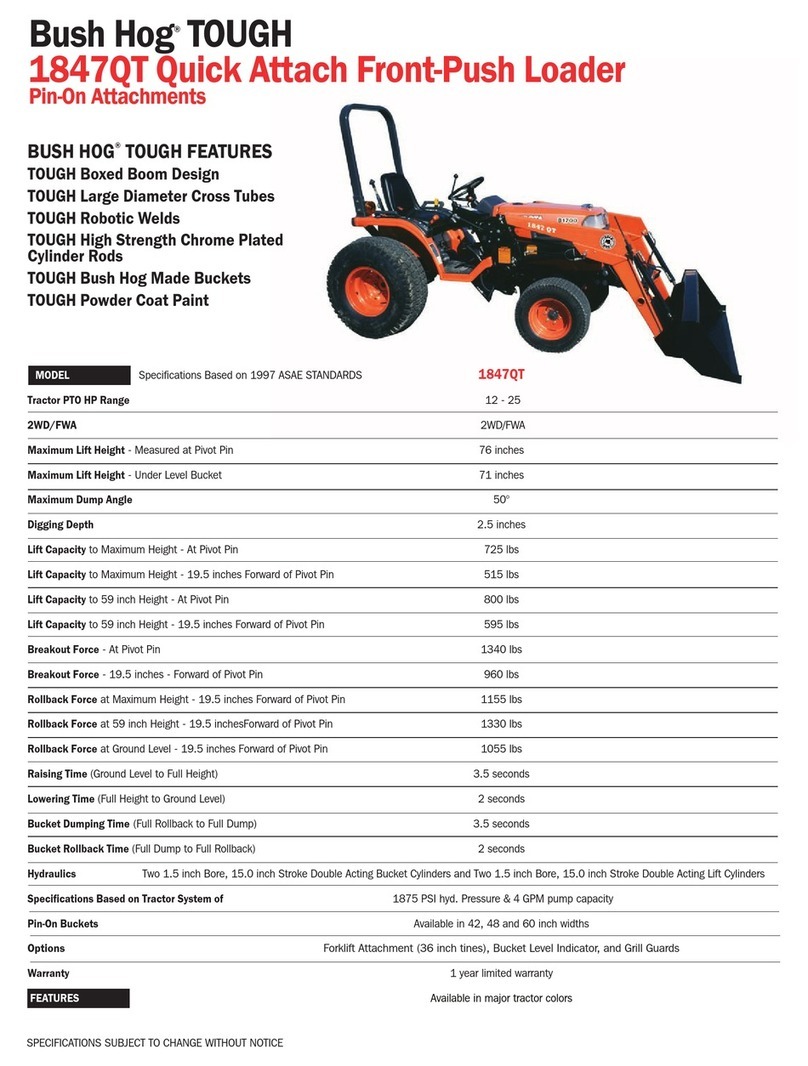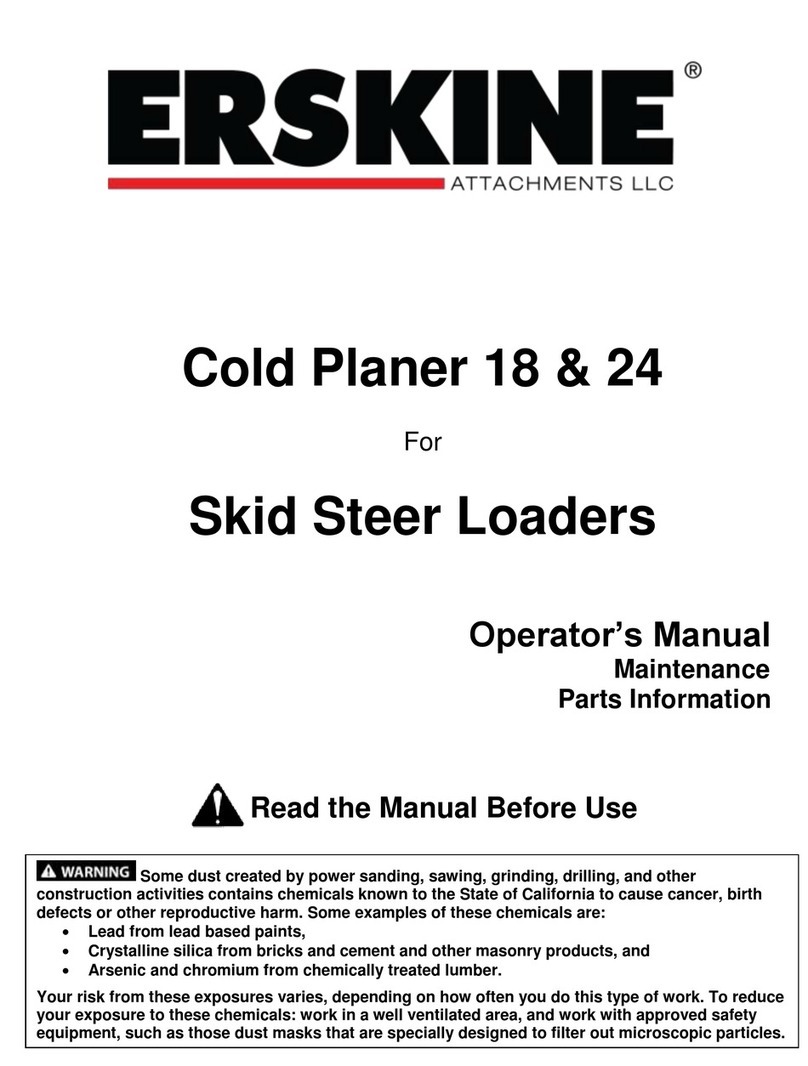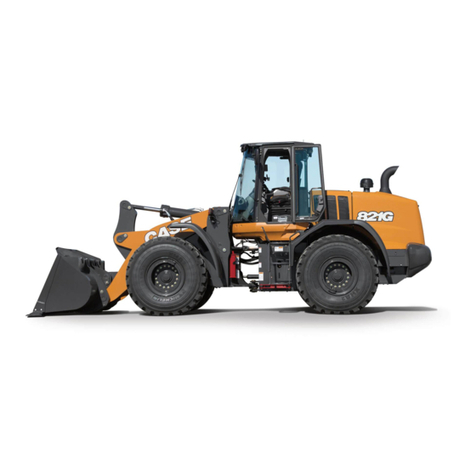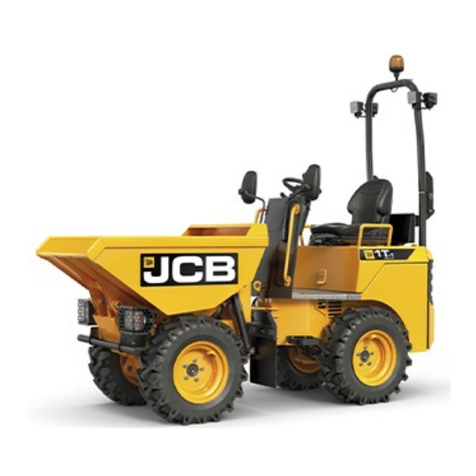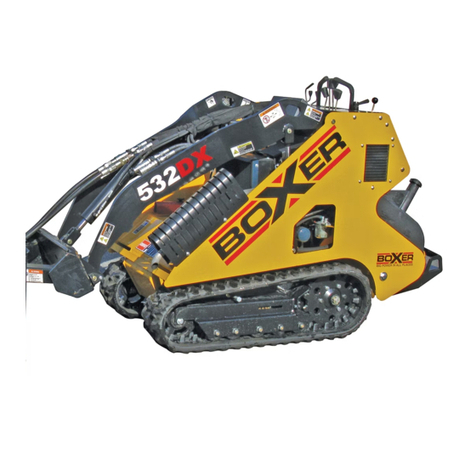Southworth PalletPal Stack-n-Go FPS2500-90 NAS User manual

OWNER’S MANUAL
Model # ______________________________________
Serial # ______________________________________
Date placed in Service __________________________
SOUTHWORTH PRODUCTS CORP
P.O. Box 1380 • Portland, ME 04104-1380
Telephone: (207) 878-0700 or (800) 743-1000
Fax: (207) 797-4734
www.SouthworthProducts.com
Email: [email protected]
PalletPal Stack-n-Go
Model FPS2500-90 NAS
For models that do not have GC or ST stamped into the mast
September 2019

2 Southworth PalletPal Stack-n-Go / FPS2500-90 NAS
PalletPal Stack-N-Go
Please note:
This manual was current at the time of printing.
To obtain the latest, most updated version, please contact
Southworth’s Customer Service Department or go to our website:
www.SouthworthProducts.com, under Parts & Service
you will nd a complete list of current
owner’s manuals to print.

Southworth PalletPal Stack-n-Go / FPS2500-90 NAS 3
SOUTHWORTH
TABLE OF CONTENTS
INTRODUCTION............................................................................................................. 5
RESPONSIBILITY OF OWNERS AND USERS .............................................................. 6
Safety Alert Symbols and Signal Words ........................................................................... 7
SAFETY PRECAUTIONS ................................................................................................ 8
INSTALLATION INSTRUCTIONS .................................................................................. 10
Inspection .......................................................................................................... 10
Removal from Pallet .......................................................................................... 10
Preparation for Use ............................................................................................ 10
Battery ................................................................................................................ 10
Set Up Procedure for PalletPal Stack-n-Go Straddle Legs ............................... 11
OPERATOR INSTRUCTIONS ....................................................................................... 12
Suggested Daily Operator Checklist................................................................... 14
BATTERY MAINTENANCE & CHARGING .................................................................... 15
MAINTENANCE ............................................................................................................ 16
TROUBLESHOOTING ................................................................................................... 17
STACKER BODY COMPONENTS................................................................................. 18
CABINET ASSEMBLY .................................................................................................... 19
CARRIAGE ASSEMBLY................................................................................................. 20
OUTRIGGER LEG ASSEMBLY...................................................................................... 21
INNER MAST ASSEMBLY.............................................................................................. 22
OUTER MAST ASSEMBLY ............................................................................................ 23
STEERING ASSEMBLY ................................................................................................. 24
CONTROL POD ............................................................................................................. 25
DRIVE WHEEL ASSEMBLY........................................................................................... 26
POWER UNIT ASSEMBLY............................................................................................. 27
CYLINDER ASSEMBLY ................................................................................................. 28
ELECTRICAL DIAGRAM................................................................................................ 29
BATTERY CONNECTION DIAGRAM ............................................................................ 30
LABEL LOCATION DRAWING ....................................................................................... 31
ORDERING REPLACEMENT PARTS ........................................................................... 32
WARRANTY STATEMENT ............................................................................................ 33

4 Southworth PalletPal Stack-n-Go / FPS2500-90 NAS
PalletPal Stack-N-Go

Southworth PalletPal Stack-n-Go / FPS2500-90 NAS 5
SOUTHWORTH
INTRODUCTION
This manual attempts to provide all of the information necessary for the safe and
proper installation, operation and maintenance of the Southworth Products battery
operated, PalletPal Stack-n-Go. It is important that all personnel involved with the
installation, maintenance or operator of the stacker read this manual. Additional
manuals are available upon request or at www.SouthworthProducts.com.
Each Southworth stacker is equipped with nameplate, serial number and model
identications. Please refer to these numbers when ordering parts or requesting
further information.
This Southworth stacker is designed for lifting, lowering and positioning a wide
variety of loads. WHERE UNIQUE SITUATIONS ARISE, WHICH ARE NOT COV-
ERED IN THIS MANUAL, CALL SOUTHWORTH PRODUCTS FOR FURTHER
INSTRUCTIONS.
The battery operated stackers are designed for dry in-plant/non-hazardous locations
only. They can be used in a 8' or larger aisle. These units are not for personnel
lifting.

6 Southworth PalletPal Stack-n-Go / FPS2500-90 NAS
PalletPal Stack-N-Go
Responsibility of Owners and Users
Inspection and Maintenance
The device shall be inspected and maintained in proper working order in accordance with
Southworth’s owner’s manual.
Removal from Service
Any device not in safe operating condition such as, but not limited to, excessive leakage, miss-
ing rollers, pins, or fasteners, any bent or cracked structural members, cut or frayed electric or
hydraulic lines, damaged or malfunctioning controls or safety devices, etc. shall be removed
from service until it is repaired to the original manufacturer’s standards.
Repairs
All repairs shall be made by qualied personnel in conformance with Southworth’s instructions.
Before Operation
Before using the device, the operator shall have:
• Read and/or had explained, and understood, the manufacturer’s operating instructions
and safety rules.
• Inspected the device for proper operation and condition. Any suspect item shall be care-
fully examined and a determination made by a qualied person as to whether it con-
stitutes a hazard. All items not in conformance with Southworth’s specication shall be
corrected before further use of the equipment.
During Operation
The device shall only be used in accordance with this owner’s manual.
• Do not overload.
• Ensure that all safety devices are operational and in place.
Modications or Alterations
Modications or alterations to any Southworth industrial positioning equipment shall be made
only with written permission from Southworth.

Southworth PalletPal Stack-n-Go / FPS2500-90 NAS 7
SOUTHWORTH
CERTIFIED OPERATOR TRAINING
You must be trained and certied to operate this powered stacker. Federal law states that only properly
trained operators are permitted to operate a powered industrial stacker and that your employer must train
you and certify that you are qualied. (OSHA 1910.178 29QFR-7-1-06 Edition)
Southworth does not offer operator training. Operator training programs may be offered by your local
Southworth dealer or obtained online. Enter, "powered industrial truck operator training" into a search
engine.
SAFETY ALERT SYMBOLS AND SIGNAL WORDS
The safety of all persons operating, maintaining, repairing, or in the vicinity of this equipment is of paramount
concern. This is a powerful machine with moving parts, and is capable of causing personal injury if proper precautions
are not taken. Therefore, throughout this manual, certain hazards have been identied which may occur in the use
of the machine, and there are appropriate instructions or precautions which should be taken to avoid these hazards.
In some cases, there are consequences which may occur if instructions or precautions are not followed. Below are
the symbols and signal words along with their denitions referenced from ANSI Z535.4 - Product Safety Signs
and Labels.
Safety Alert Symbols
These are the safety alert symbols.. They are used to alert you to potential physical injury haz-
ards. Obey all safety messages that follow this symbol to avoid possible injury or death.
For use with DANGER signal word
(Red Background)
For use with WARNING signal word
(Orange Background)
For use with CAUTION signal word
(Yellow Background)
Signal Words
The meaning of different signal words as dened by ANSI Standard Z535.4 indicates the relative
seriousness of the hazardous situation.
DANGER indicates a hazardous situation which, if not avoided,
will result in death or serious injury.
WARNING indicates a hazardous situation which, if not avoided,
could result in death or serious injury.
CAUTION, used with the safety alert symbol, indicates a haz-
ardous situation which, if not avoided, could result in minor or
moderate injury.
NOTICE is used to address practices not related to personal
injury.
(Red Background)
(Orange Background)
(Yellow Background)
(Blue Background)
SAFETY
INSTRUCTIONS
SAFETY INSTRUCTIONS (or equivalent) signs indicate safety-
related instructions or procedures.
(Green Background)

8 Southworth PalletPal Stack-n-Go / FPS2500-90 NAS
PalletPal Stack-N-Go
The battery operated stackers are very powerful lifts
capable of doing large amounts of work.
DO NOT OPERATE THESE LIFTS WITHOUT
CAREFULLY READING THIS MANUAL. In order
to provide for the safe operation of these stackers,
Southworth has identied certain hazards that may oc-
cur during the maintenance and use of these lifts. For
safety reasons these units are designed to be serviced
or repaired in the fully lowered position. If performed
properly, this will greatly reduce the possibility of
injury.
WARNING!
When servicing the unit:
1. Key should be in "OFF" position.
2. E-stop should be depressed.
3. Disconnect the batteries at the terminals.
• Do not perform any repair work on lifts if
there is a load on the forks or platform.
• Do not perform any repair work if the forks
or platform is in the raised position.
• All personnel must stand clear of the lift
while in motion.
• Do not put hands or feet under the forks or
platform.
• Do not stand underneath the forks or plat-
form.
• Do not stand in front of the stacker while in
motion.
• Do not stand, sit or climb on the lift.
• Do not use the lift on soft, uneven or unstable
surfaces.
• Do not exceed the load center or capacity.
WARNING!
You or others around you can be seriously injured
or even killed if you don't use this stacker correctly.
Read and obey all warnings and instructions in this
manual and on the stacker. It is your responsibil-
ity before starting work to make sure it is in good
working order.
Always be alert to the area around you and watch where
you are walking. Be careful that you don't get pinned
or crushed between the stacker and a xed object such
as a wall or post.
• Watch your hands and feet. A foot or hand
caught between the stacker and a xed object will
be crushed or even cut off.
• If traveling forks rst, keep both hands on
the control handle and be careful when changing
direction of travel. Keep your feet clear of the
stacker.
• Keep the stacker under control at all times.
Operate at a speed that allows you to stop safely.
Be even more careful on slippery or uneven sur-
faces. Do not run over objects on the oor.
• Perform all stacker movements smoothly and
at a speed that will give you time to react if an
emergency occurs.
Tipovers and falls are very serious accidents; you can
be crushed or even killed. To prevent injury, know
where you are at all times and follow the rules of safe
stacker operation.
• Be careful when working around docks,
dockboards and trailers. Stay away from the
edge of docks and ramps. Check to make sure the
wheels of truck or trailers are chocked.
• Travel with the load or forks close to the
ground. Watch for overhead obstructions. Per-
form all stacker movements smoothly and at a
speed that will give you time to react in an emer-
gency.
• Keep your hands and feet away from all mov-
ing parts such as masts, chains, forks or wheels.
• Never stand on or under the forks, or allow
anyone else to stand on or under them. Never ride
on the stacker or allow anyone else to ride. There
is no safe place to sit or stand.
• Before you leave your stacker, be sure to
lower the forks to the oor. Shut the stacker off
with the key.

Southworth PalletPal Stack-n-Go / FPS2500-90 NAS 9
SOUTHWORTH
WARNINGS
DO NOT use this stacker until you have been trained
and authorized to do so.
DO NOT operate until you have read all warnings and
instructions.
DO NOT exceed load center or load weight capacities
(check capacity plate).
DO NOT operate until you have checked the conditions
of the stacker: lift systems, forks, chains, and cables.
DO NOT use if any part is damaged, worn or not work-
ing properly.
DO NOT use on ramps or inclines. Only smooth level
surfaces.
DO NOT use for lifting or carrying people.
DO NOT handle unbalanced, unstable or loosely
stacked loads.
DO NOT travel with forks or platform in an elevated
position.
DO NOT handle tall, unsecured or unstable loads that
could fall.
DO NOT allow people to stand or pass under forks or
platform with or without load.
DO NOT operate when parts of anyone’s body may be
close to mast structure or any moving parts.
DO NOT drop loads on platform or forks.
DO NOT alter or modify this stacker in any way.

10 Southworth PalletPal Stack-n-Go / FPS2500-90 NAS
PalletPal Stack-N-Go
INSTALLATION
A. INSPECTION:
Upon receipt of the stacker, inspect the equipment com-
pletely to determine if there is any shipping damage, and
that the lift is complete. Southworth tests and inspects
every piece of equipment prior to shipment. If damage
is apparent, a freight claim must be led with the freight
company. Do not use the stacker if there appears to be
any damage. With the stacker in a lowered position,
check the following:
• Check for signs of damage especially to the
back cabinet that houses the battery, electrical/
hydraulic power pack.
• Check all electrical and hydraulic connec-
tions for tightness.
• Remove back panel.
1. Turn key switch to "OFF" position.
2. Push in E-stop and unscrew the red knob,
3. Lift off back panel. There is enough wire
to the key switch to allow the panel to be set
aside.
• Inspect for any bent or damaged parts.
B. REMOVING FROM PALLET
Each of the Southworth stackers is shipped out on a
pallet or skid. Prior to removing the unit from the pal-
let or skid, remove all tie down straps and packaging.
Visually inspect the unit as closely as possible.
With an overhead hoist or forklift, carefully pick up the
unit taking into consideration the center of gravity of the
unit. If you choose to pick the unit with an overhead
hoist, use a nylon sling and hoist with a minimum of
2,000-lb. capacity. The nylon sling will not do any dam-
age to the steel construction of stacker. Pick the unit
up. On conventional masts use the top crossmember of
the lift. On narrow masts the cover must be removed
to access lifting equipment. Be careful of the stacker
swinging once fully lifted off the pallet or skid. Have
all personnel completely cleared from the area.
Pick the unit up approximately six inches above the
pallet or skid. Once raised, remove the pallet or skid
from below the lift. Do not move the lift around in the
air. Lower the stacker on the ground.
C. PREPARATION FOR USE
This stacker left our factory in new condition. It has been
inspected and weight tested to assure all performance
standards have been met.
Visually inspect the stacker for damage. Check for at-
tachments and accessories that may have been ordered.
If there is any damage or missing parts, report it to your
carrier and your Southworth dealer immediately.
Remove all metal/plastic bands, cardboard and other
material used for shipping purposes.
Check to see if chains are in place, and that the lift sys-
tem is in working order. Inspect for oil leaks.
Connect battery cable. Check cables and wires on bat-
tery charger as well as battery.
Figure 1: Operational buttons BELLY BUTTON SWITCH
LIFT UP
LIFT DOWN
HORN
SPEED CONTROL
DIRECTION CONTROL

Southworth PalletPal Stack-n-Go / FPS2500-90 NAS 11
SOUTHWORTH
Back off all bolts and follow steps.
First - tighten Bolt 1 to 85 foot pounds.
Second - tighten Bolt(s) 2 to 85 foot pounds.
Third - tighten Bolt 3 to 25 foot pounds - NOT 85.
Last - securely tighten all lock nuts.
Set up procedure for Stack N Go Straddle legs with 3 or 4 Bolts:
Proper Drive Wheel traction is obtained for the Stack N Go Straddle unit using this Procedure
All Stack N Go Models are designed and intended to operate on an unnished concrete oor surface. If any
Stack N Go is operated on smooth or polished concrete, sealed concrete, epoxy sealed oor, linoleum or
other smooth surfaces Drive Wheel traction performance may be affected; If traction issues are encountered
Rubber Drive Wheels are available through special order. Please contact Customer Service.
When any Stack N Go is operated on a wet, oily, powdery, sandy or non-uniform liquid or granular surface
Drive Wheel traction performance will be affected and loss of traction will occur.
SET-UP PROCEDURE FOR STACK N GO STRADDLE LEGS
NOTE: STRADDLE LEGS MUST BE ADJUSTED IN ACCORDANCE WITH THIS PROCEDURE
1. Stack N Go unit located on at, clean uniform surface, unloaded, forks raised a minimum of 1” off the oor
2. Determine the desired/required straddle width dimension (2 inches greater than pallet width, 1” on each side of
the pallet or load, up to a maximum of 50 inches inside width)
3. Be sure to fully loosen all bolts before moving stabilizing legs. Adjust one stabilizer leg at a time – using a pry
bar, pinch bar, rubber mallet etc. move the straddle leg out from the base tube to the desired position. Do not
move too far, see picture below, if the ¼” wide painted White Line is visible the leg is pulled out too far; Maxi-
mum movement 5 ½” for each leg for 2200 pound units, 4 ½” for each leg for 3000 pound units.
4. Adjust second Straddle Leg – using a pry bar, pinch bar, rubber mallet etc. move the straddle leg out from inside
the base tube to the desired straddle width position.
5. Straddle Legs must be symmetrically adjusted, both legs adjusted to the same extended dimension!
CRITICAL – STRADDLE BOLT TIGHTENING SEQUENCE & PROCEDURE
CRITICAL PROCEDURE FOR PROPER WHEEL TRACTION
Bolts
Bolt
Bolt
5½"
NOTE:
When adjusted correctly, white
line cannot be seen.

12 Southworth PalletPal Stack-n-Go / FPS2500-90 NAS
PalletPal Stack-N-Go
OPERATION
A. OPERATING INSTRUCTIONS:
AUTHORIZED OPERATORS SHOULD READ
AND UNDERSTAND ALL INSTRUCTIONS,
PRECAUTIONS AND WARNINGS.
IMPROPER USE OF THIS LIFT TRUCK
COULD RESULT IN INJURY AND/OR
DAMAGE TO LOAD AND EQUIPMENT.
To Raise and Lower:
There are two buttons located on both sides of the
handle. The inside one is for raising the forks. The
outside one is for lowering the forks. When operating,
always make sure the load being lifted is within the
loading capacity of your stacker and the load has been
stacked safely on the pallet. Also, make sure that the
length of the forks corresponds to the length of the pal-
let. In this way, the load rollers will place themselves
in the opening at the end of the pallet, so that when you
raise the forks, you will not break the bottom boards
of the pallet. Always make sure that when entering the
pallet that the forks are in the fully lowered position.
Be careful when lifting pallets that are too short or too
long for the stacker. It might destroy your pallet by
breaking the bottom boards, and if the forks project
through the end of the pallet, the tips of fork may go
into the next pallet that is behind the pallet that you are
lifting, which may bend the tips of forks and overload
the capacity of the stacker.
Travel Function:
To travel, rotate the buttery controls throttle on the
upper part of the handle. When rotating the buttery
control CW towards the forks, the stacker runs forwards
in the forks rst direction. When rotating the buttery
CCW towards you, the stacker runs backwards in the
handle rst direction. Always make sure the stacker
clears any obstruction when traveling, and that your path
of travel is clear of people. Never carry loads above the
loading capacity of the stacker. It is suggested that when
traveling without a load, the forks be in the lowered
position. The speed of the stacker is increased by the
degree of the rotation in either direction; it functions
like a throttle. When you release your hand from the but-
tery control, it automatically will resume to the neutral
position and the speed of the stacker will slow down.
Electric Brake:
Your stacker is equipped with an electric magnetic
brake. The brake is applied when the handle is in its
vertical position between 10 – 15 degrees and lowered
position between 80 – 90 degrees. The brake could be
released when you pull down the handle at any point
between 15 – 80 degrees. Always make sure the brake is
released before operating the stacker. When the stacker
is running, you could brake the stacker by raising the
handle to its vertical position or lowering the handle to
its lowest position. Or, to turn the buttery controls in
the opposite direction, the change in direction of the
motor will slow down, stop, and reverse the direction
of stacker. When parked, always put the handle in the
full vertical position with the brake applied and the
forks in lowered position.
Reversing Safety:
At the end of the handle there is a large, red reversing
bar (belly button switch) that is designed to protect
the operator from injury. When the operator runs the
stacker backwards, and the end of the handle comes
in contact with the operator’s body, the stacker will
automatically reverse direction and travel away from
the operator. When the reversing safety bar comes in
contact with your body during operation, immediately
release your hands from the buttery control and put the
handle up to its vertical position or down to its lowest
position and the brake is on. The reversing safety bar
will automatically resume to its original position after
being activated.
Horn:
As standard equipment, a horn that is located on the
top of the handle.

Southworth PalletPal Stack-n-Go / FPS2500-90 NAS 13
SOUTHWORTH
• Inspect the lift for damaged or worn parts.
Do not use if not in safe operating condition.
• Use lift on hard level surfaces only.
• Make sure load is evenly distributed, not
loose or unstable, and is as far back on platform
or forks as possible. Do not pick up loads on tips
or forks or edge of platform.
• For fork models, adjust forks to the maxi-
mum practical width. Pick up loads on both
forks.
• Do not overload. Check load center and load
weight capacities on the nameplate.
• Make sure travel and work area is clear of
obstructions.
• Check overhead clearance before lifting loads
or transporting.
B. DAILY OPERATIONS
MAINTENANCE CHECKS:
1. Battery
A. Check for corroded and loose terminals.
A white powder substance will be present if
there is any existing corrosion.
B. Visually inspect for any cracks or damage
to the casing.
C. Check for loose battery tie-downs.
2. Charger
A. Inspect wire connections.
B. Check power cord for nicks/damage.
C. Check power charger for proper mounting.
3. Hydraulic System
D. Inspect pump and cylinder for oil leaks.
E. Check hydraulic oil level.
F. Check hydraulic ttings and hoses.
G. Check ram for nicks/damage.
4. Frame Assembly
A. Check chain roller assembly connections.
B. Check for any worn or damaged parts.

14 Southworth PalletPal Stack-n-Go / FPS2500-90 NAS
PalletPal Stack-N-Go
DAILY OPERATOR CHECK LIST
CHARGE CONDITION/BATTERY CHECK LIST
1. Check Battery Discharge Indicator (Fuel Gage and Hour Meter) – Be sure unit is
showing proper Charge Level before operating unit
2. Check to be sure Charging Cord is Unplugged and properly stowed before operat-
ing unit
3. Inspect Battery Wire Connections – All connections should be tight with No Corro-
sion (white powder) showing at the Battery Terminals
4. Inspect Battery Case – There should be no cracks or visible damage to the Battery
Case
WALK AROUND INSPECTION
1. Check general condition of Stacker (loose or broken parts, oil, dangling wires, dents,
cracked covers etc.)
2. Check metal frame, mast, carriage and font load supports for cracked welds, worn or
at rollers, loose or disconnected chains, loose pins, missing snap rings, and loose or
missing hardware – bolts, nuts washers etc.
3. Check for evidence of hydraulic leaks
4. Make sure all precautionary labeling is in place and legible
FUNCTIONAL INSPECTION
1. Check Drive – Forward and Reverse Function
2. Check Lift – Up and Down Function
3. Check Function for Belly Button Reverse
4. Check Horn Function
5. Check Brake Function
OPERATOR ID DATE
DO NOT USE OR OPERATE STACKER IF ANY FUNCTION IS NOT
OPERATING PROPERLY OR IF STACKER APPEARS UNSAFE IN ANYWAY
REPORT CONCERNS TO SUPERVISOR IMMEDIATELY!

Southworth PalletPal Stack-n-Go / FPS2500-90 NAS 15
SOUTHWORTH
BATTERY MAINTENANCE
A. PREPARING TO CHARGE A BATTERY
1. Always turn off E-stop and key switch before work-
ing with the batteries.
2. Be sure the area around the stacker and the battery
is well ventilated while battery is being charged.
3. The battery terminals, connections and wiring
connections should be clean and free of corrosion.
When cleaning any of these components wear a face
shield or other suitable protective eyewear.
B. BATTERY CHARGING
Charging must be performed with the charger that is
provided with or prewired into the machine. During
charging, the temperature in the battery must not exceed
120 F. Charging simultaneously with truck operation
is not recommended. Plug the charger into a 115 volt
outlet. Charge until the battery gauge indicator lights
show fully charged (approximately 6-8 hours).
C. WARNINGS AND BATTERY INFORMATION
Avoid use of open ame near batteries. At temperatures
around freezing point, battery capacity is reduced by
30%. The battery terminals, connections and wiring
should be clean and free of corrosion. When cleaning
any of these components, wear a face shield or other
suitable protective eyewear. Read, understand, and fol-
low all battery and battery manufacturer's specic pre-
cautions while working with and/or charging batteries.
D. BATTERY MAINTENANCE
To measure the voltage, use a digital voltmeter (DC) on
the battery poles. The truck must not have been in use
for the previous 30 minutes.
DANGER
Never alter the AC cord or plug provided. If it will
not t outlet, have proper outlet installed by a quali-
ed electrician. Improper connection can result in a
risk of an electric shock.
1. Disconnect the charger from the 115 volt wall out-
let once the indicators read fully charged.
Note: The batteries are designed for intermittent
use. Continual usage will wear the battery out and
charging will be required.
E. CHARGER OPERATION
Power Lamp
1. Green: Connection correct. Charger will operate
normally.
2. Red: Bad connection or bad battery.
Fault
1. Red light blinks 3 times in 5 seconds: The output
between charger is faulty, loose, or bad connection
2. Red light blinks 5 times in 5 seconds: The tempera-
ture is too hot for the charger to operate.
3. Building power is not compatible; too low or too
high. +- 10% is the general rule.
Charge Lamp
1. Red: Charger can charge normally. The battery is
less than 70%
2. Orange: Battery is between 70% and 100% charged.
3. Green: Battery is at 100%. Fully charged.
4. No light: The charger can not charge the battery.
Voltage of the battery may be too low to cause the char-
ger to start. It must be at 10.5 volts to initiate charge.
VOLTAGE
Approx. 12.7 V Fully charged
Approx. 12.2 V 1/2 charged
Approx. 12.0 V 1/4 charged
Approx. 11.6 V Discharged

16 Southworth PalletPal Stack-n-Go / FPS2500-90 NAS
PalletPal Stack-N-Go
MAINTENANCE
Operation of Southworth Stack N Go is very simple
— as is their construction. They require very little
maintenance. Reasonable care will result in excellent
trouble-free performance. The Stack N Go is designed
for one-man operation and ease of performance.
• Grease oor wheels and casters at least once
a month
• Use only Hydraulic Oil AW32 or Dextron III
in the hydraulic system.
• Do not overload your lift.
• Check brakes, steering mechanisms and con-
trols before each use.
A. WEEKLY OPERATIONS
MAINTENANCE CHECKS:
DAMAGE: Check for bent, dented, worn or broken
parts.
LIFT SYSTEM: Check to assure that there is no bind-
ing or excessive play in the forks. Check for quiet and
smooth operation of the lift cylinder. Check all moving
parts and linkage.
LEAKS: Check hydraulic system for leaks and hydru-
alic oil level.
WHEELS AND CASTERS: Check for wear and that
they are turning smoothly.
LIFT CHAINS: Check to see that they are in place
and not loose.
FORKS: Check that they are not bent or cracked.
BRAKES: Ensure brakes work properly.
CABLES; WIRES: Check that there are no loose
cables or wires.
LABELS: Ensure all precautionary labels and guards
are in place.
B. MONTHLY OPERATIONS
MAINTENANCE CHECKS:
1. Battery (maintenance free)
A. Clean terminals.
B. Clean battery compartment area if there are
signs of corrosion.
2. Hydraulic System
A. Clean and inspect hydraulic cylinder.
B. Lubricate chain with a rust inhibitive lubri-
cant (light machine oil).
C. Check chain tension. It should be even
on both chains. The chain should be tight
enough so that it does not come off of the
roller assembly.
3. Frame Assembly
A. Clean and lubricate all roller bearings, cam
followers and all moving parts.
B. Clean and inspect all welds.
C. Check wheels for wear and damage.
D. Inspect nameplate for legibility. Place the
serial and model number shown on the name-
plate on the cover of the manual for future
reference.
4. Electrical
A. Check batteries, motors, controllers, limit
switches, electrical conductors and connec-
tions.
CAUTION:
DO NOT USE LIFT IF IT IS NOT
OPERATING PROPERLY,
OR APPEARS UNSAFE IN ANY WAY!

Southworth PalletPal Stack-n-Go / FPS2500-90 NAS 17
SOUTHWORTH
TROUBLESHOOTING
Before starting the troubleshooting, you have to:
A. Put the truck on an even and solid surface.
B. Turn off key switch or disconnect the battery ter-
minals.
1. Unit will not lift (motor does not
run)
• Faulty wiring from fuse to lift switch in handle
• Faulty lift switch
• Faulty wiring from battery positive terminal to
pump contactor to pump motor
• Burned out brushes in pump motor
• Low hydraulic pressure caused by:
¨ Pressure relief valve needs adjustment
¨ Pump check valve stuck open
¨ Faulty solenoid valve
• Faulty wiring from lift switch to solenoid
• Faulty lift contactor
• Defective control circuit fuse
• Chain or roller bound
• Check oil level
2. Forks will not lower
• Look for binding in chains or rollers
3. No electrical power
Dead Batteries:
¨ Keyswitch on "OFF" position
¨ E-stop button depressed
¨ Loose or dirty battery connections
¨ Blown fuse(s)
• Faulty wiring from fuse to travel control switch
• Faulty control switch
• Faulty wiring from travel control switch direction
contactor
• Faulty contactor
4. No Traction
• Idler wheel needs adjustment
IDLER WHEEL ADJUSTMENT
The following is a procedure for adjusting the idler
wheel on the Southworth Stack N Go. Under normal
conditions this should not be necessary becaus the idler
wheel has been adjusted at the factory.
Tools Needed:
Phillips head screw driver
Medium crescent wrench
1 block of wood (2 x 4)
1. Place unit on a at surface.
2. Turn key to the OFF position and push emergency
stop button down.
3. Remove the 2 screws from the main orange cover
that covers the unit.
4. Remove the emergency stop button by unscrewing.
5. Slide the main cover up and place the block of wood
under the right hand side to hold open exposing the
idler wheel and adjusting the screw.
6. With the adjustable wrench loosen the jam nut on
the idler wheel adjusting screw.
7. Loosen the adjusting screw until you have no ten-
sion between the adjusting screw and idler wheel.
You will have some play between the idler wheel
and the left front wheel.
8. Now tighten the screw until you just make contact
with the idler wheel. Continue adjusting until the
idler wheel just touches the oor.
9. Tighten jam nut. You may have a slight rocking
back and forth, from the left front to right rear idler
wheel, but this is not uncommon.
10. Now remove the wooden block and lower the cover
back into place inserting the 2 screws and tighten.
Screw the E-stop button back on.
11. Your adjustment is complete
If the wheel is worn, replace wheel.

18 Southworth PalletPal Stack-n-Go / FPS2500-90 NAS
PalletPal Stack-N-Go
STACKERBODYCOMPONENTS
Item Description Qty
1 LegAssy 1
2 OuterMastAssy 1
3 InnerMastAssy 1
4 LiftFrameAssy 1
5 RearBoxAssy 1
6 SteeringAssy 1

Southworth PalletPal Stack-n-Go / FPS2500-90 NAS 19
SOUTHWORTH
CABINETASSEMBLY
Item Description Qty Item Description Qty Item Description Qty
1 PowerUnit 1 12 BatteryBoxCover 1 23 Bolt 4
2 DriveCover 1 13 Battery2 24 Washer 4
3 BatteryCharger 1 14 BatteryMeter 1 25 Nut 4
4 SteeringCover 1 15 KeySwitch 1 26 CasterWheel 1
5 BodyWeldment 1 16 E‐StopSwitch 1
6 RearBoxCover 1 17 Bolt 2
7 CoverHolder 1 18 Washer 2
8 ElectricalCompon
e
1 19 BatteryHolder 2
9 Screw 6 20 Bolt 2
10 Washer 2 21 Washer 4
11 Bolt 2 22 Nut 4

20 Southworth PalletPal Stack-n-Go / FPS2500-90 NAS
PalletPal Stack-N-Go
CARRIAGEASSEMBLY
Item Description Qty Item Description Qty
1 Fork 2 6 SnapRing 4
2 SnapRing 2 7 LiftFrame 1
3 ForkShaft 1 8 SnapRing 4
4 RollerWheel 4 9 CarriageRollerWheel 4
5 RollerWheelShaft 4
Table of contents
Other Southworth Compact Loader manuals
